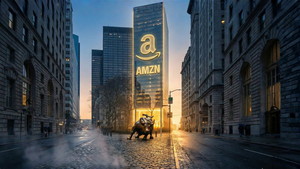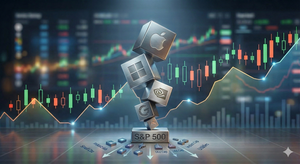Amazon's Grocery Gambit: Same-Day Fresh Delivery Reshapes Retail Landscape

Amazon's (NASDAQ: AMZN) latest strategic maneuver, the expansion of its fresh grocery offerings with same-day delivery to over 1,000 cities and towns, is sending ripples through the retail and delivery sectors. This aggressive push aims to integrate perishable items seamlessly into its vast logistics network, promising a "one-stop shopping experience" for consumers. The immediate fallout has seen shares of traditional grocery giants like Kroger (NYSE: KR) and delivery powerhouses such as DoorDash (NASDAQ: DASH) experience declines, signaling market apprehension about the intensified competition and potential disruption to their core businesses.
Amazon's Fresh Offensive: A Strategic Imperative
This significant expansion by Amazon is not merely an incremental service upgrade; it represents a calculated move to capture a larger slice of the lucrative grocery market. By extending same-day delivery for fresh groceries to a vast swathe of the United States, with plans to reach over 2,300 cities by year-end, Amazon is directly challenging the established order. The company is leveraging its extensive Prime membership base, offering free same-day delivery for orders over $25 (with a nominal fee for smaller purchases), thereby lowering the barrier to entry for quick, spontaneous grocery shopping. This initiative is designed to foster greater customer loyalty and increase purchase frequency on Amazon's platform, as evidenced by their observation that first-time grocery shoppers using this service tend to return twice as often.
The timeline leading up to this moment has seen Amazon steadily build its grocery capabilities, from the acquisition of Whole Foods Market (NASDAQ: AMZN) in 2017 to the gradual rollout and refinement of its Amazon Fresh and Amazon Go stores. This latest expansion is a culmination of years of investment in specialized temperature-controlled fulfillment networks and sophisticated logistics. Key players involved include Amazon's vast network of fulfillment centers and delivery drivers, as well as its technology teams focused on optimizing inventory management and predicting local customer preferences through advanced AI models. Initial market reactions have been swift, with investors expressing concern over the potential impact on traditional grocers and third-party delivery services, leading to a dip in their stock prices.
Winners and Losers in the Grocery Wars
Amazon's bold move is poised to create clear winners and losers in the evolving retail and delivery landscape. The most apparent beneficiary is Amazon itself. By integrating fresh groceries into its Prime ecosystem, the company enhances the value proposition of its membership, potentially attracting new subscribers and deepening engagement with existing ones. This expansion also allows Amazon to collect more frequent and granular consumer data related to grocery purchases, providing a significant analytical advantage for refining its AI models and optimizing its supply chain. Furthermore, it reinforces Amazon's logistical dominance, showcasing its ability to handle complex, temperature-controlled supply chains for perishable goods.
On the other hand, traditional grocery chains like Kroger (NYSE: KR), Walmart (NYSE: WMT), and Target (NYSE: TGT) face intensified competition. While these companies have invested heavily in their own online grocery and delivery services, Amazon's scale, technological prowess, and established Prime membership base present a formidable challenge. The market's initial reaction, reflected in the decline of their shares, underscores the perceived threat to their core business. Similarly, third-party delivery platforms such as DoorDash (NASDAQ: DASH) and Uber (NYSE: UBER) are likely to experience a "directional negative" impact. As Amazon internalizes more of its grocery delivery, it could lead to margin pressure for these companies, particularly in their intra-week delivery efforts, as a significant portion of their business relies on grocery and convenience store partnerships.
Industry Impact and Broader Implications
Amazon's grocery expansion fits squarely into the broader industry trend of e-commerce giants encroaching upon traditional retail sectors, particularly those with high-frequency purchase cycles like groceries. This move signifies a further blurring of lines between online and offline retail, pushing the entire industry towards a more integrated, omnichannel approach. The potential ripple effects are significant: competitors will be forced to accelerate their own digital transformation efforts, invest more heavily in last-mile delivery, and potentially explore new partnerships or consolidation to compete effectively.
From a regulatory standpoint, Amazon's increasing dominance across multiple sectors could draw further scrutiny from antitrust bodies. As the company expands its reach into essential services like groceries, concerns about market concentration and fair competition may intensify. Historically, similar aggressive expansions by large corporations have often led to increased regulatory oversight. For instance, Walmart's rapid expansion in the late 20th century prompted discussions about its impact on local businesses and labor practices. Amazon's current strategy, while different in its digital-first approach, shares the characteristic of leveraging scale and efficiency to disrupt established markets. The company's ongoing investment of over $4 billion to triple the size of its delivery network by 2026, with a focus on small towns and rural communities, further solidifies its competitive advantage and could raise questions about market access for smaller players.
What Comes Next
In the short term, we can expect a heightened competitive response from traditional grocers and third-party delivery services. This will likely manifest in increased marketing spend, more aggressive pricing strategies, and further investments in their own delivery infrastructure and loyalty programs. Companies like Kroger and Walmart will need to emphasize their unique strengths, such as physical store presence for in-person shopping and click-and-collect options, while simultaneously enhancing their online offerings to match Amazon's convenience.
Long-term, this move could accelerate the consolidation within the grocery and delivery sectors. Smaller players may find it increasingly difficult to compete with Amazon's scale and efficiency, potentially leading to mergers, acquisitions, or even exits from the market. New market opportunities may emerge for technology providers specializing in supply chain optimization, last-mile delivery solutions for non-Amazon entities, and personalized customer experience platforms. The potential scenarios range from a highly concentrated grocery market dominated by a few large players to a more fragmented landscape where niche players thrive by offering specialized products or services that Amazon cannot easily replicate. Investors should watch for strategic pivots from Amazon's competitors, their financial performance in the face of this new competition, and any potential regulatory actions that could shape the future of the industry.
Conclusion
Amazon's expansion into same-day fresh grocery delivery is a pivotal moment for the retail and delivery industries. It underscores the company's relentless pursuit of market share and its ability to leverage its technological and logistical prowess to disrupt established sectors. The immediate impact on traditional grocers and third-party delivery services highlights the intense competitive pressures they now face.
Moving forward, the market will be characterized by increased innovation, strategic partnerships, and potentially, further consolidation. The lasting impact of this move will likely be a more integrated and efficient grocery supply chain, driven by consumer demand for speed and convenience. Investors should closely monitor the responses of Amazon's competitors, the evolution of consumer preferences, and any regulatory developments that could influence the competitive landscape in the coming months. The grocery wars have officially escalated, and the battle for the consumer's pantry is far from over.
More News
View More




Recent Quotes
View More
Quotes delayed at least 20 minutes.
By accessing this page, you agree to the Privacy Policy and Terms Of Service.